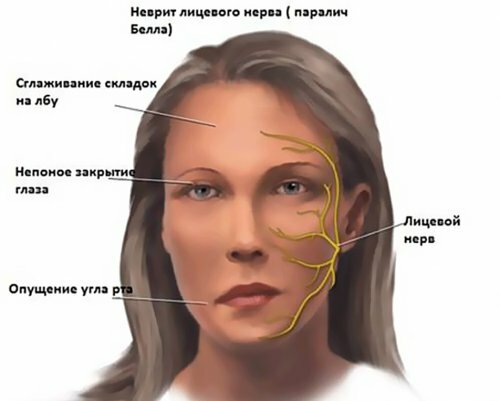Vegetovascular dystonia: what is VSD, symptoms and treatment
The diagnosis of "VSD" is very strange. With vegetative vascular dystonia, serious somatic disorders are rarely detected. According to the results of the examination, the person is completely healthy.
Some doctors attribute their appearance to a long overwork. Others think patient's invention.
In this article, we will try to explain in detail, as far as possible, in simple language what constitutes a diagnosis of vegetative-vascular dystonia, what are the symptoms, causes and methods of treatment.
Content
- What is vegetative vascular dystonia?
- The mechanism of development of VSD
- Causes of vegetative vascular dystonia
- Risk group
- First manifestations (symptoms)
- Cardiovascular disorders in VSD
- Digestive tract disorders with VSD
- Respiratory dysfunctions
- Disorders of the genitourinary system
- Thermoregulation disorders in VSD
- Psycho-emotional disorders
- Musculoskeletal manifestations
- Symptoms of exacerbation of VSD
- What examinations do you need to undergo?
- Treatment of vegetative-vascular dystonia
- Medicines for the treatment of VSD
- Prevention and recommendations
- Forecast
What is vegetative vascular dystonia?
VSD (otherwise vegetative vascular dystonia or neurocirculatory dystonia) - is not a disease, but a whole symptom complex of disorders in the autonomic-neurological system.
According to WHO statistics, 70% of the world's population has a diagnosis.
Its first manifestations are usually found in childhood and adolescence, when the formation of the body takes place.
Neurocirculatory dystonia, aka VSD, always accompanied by various signs. Symptoms include heart pain, cardioneurosis, constant fatigue, insomnia, poor memory.
It is quite difficult to cure VSD, but it is possible. The main thing is to seek medical help in a timely manner. You should be prepared for the fact that therapy will take a long time.
The mechanism of development of VSD

It is not easy for ordinary people to understand the complexity of this diagnosis. Considering the mechanism of development of pathology, it is necessary to move on to the issues of anatomy.
The autonomic system is a component of the central nervous system (CNS). It includes two sections - sympathetic and parasympathetic. They continuously regulate the work of internal organs, ensuring their high-quality functionality. For example, they contribute to the urge to defecate, provoke the feeling of hunger, the desire to sleep.
For a share sympathetic division have to work to activate vital processes, and parasympathetic - for relaxation and rest.
The vegetative system is responsible for the functioning of the body, alternately starting or slowing down the functioning of each organ. With this mechanism, a person does not need to think about how to breathe, move limbs or produce gastric juice.
Under the influence of certain factors, the continuous operation of the vegetative system can malfunction. As a result violated a strong balance between its two departments.
The vegetative component of the body's reactions to stimuli is not controlled by human consciousness, this allows us to consider it autonomous.
Major role in regulation of autonomic reactions belongs to mediators - biologically active substances that conduct a regulatory signal through synapses (compounds):
- acetylcholine;
- cortisol;
- adrenalin;
- norepinephrine;
- serotonin;
- dopamine;
- histamine;
- gamma aminobutyric acid (GABA);
- choline.
From the release of these compounds into the blood, the presence of receptors sensitive to them autonomic response depends the body to an irritant.
Causes of vegetative vascular dystonia

All causes of vascular dystonia can be divided into two conditional groups: primary and secondary.
To the first category includes hereditary predisposition and damage to the central nervous system (the main part of the nervous system) of the fetus in the last trimester of pregnancy.
Such violations are facilitated by abuse alcoholic beverages or medicines by the mother during the period of bearing the baby. This leads to a kind of reaction to stressful experiences, neuroses or emotional imbalance.
The second group of reasons: the consequences of stress, trauma, surgery, both on the central structures of the autonomic system and on the peripheral centers.
Read also:Trigeminal neuralgia: symptoms and treatment
Among secondary causes VSD should be noted:
- all kinds of diseases of the chronic course;
- craniocerebral trauma of varying severity;
- operations on the brain and spinal cord;
- mechanical damage to peripheral formations responsible for impulse conduction;
- strong psycho-emotional stress;
- poisoning with damage to important central structures;
- operations to remove organs and nerves feeding the corresponding organs.
- frequent and prolonged depression;
- hormonal imbalance during puberty;
- a sudden change in climate;
- deficiency of some vitamins and nutrients;
- mental strain;
- addictions (smoking, alcohol);
- periodic intoxication;
- violation of metabolic processes.
Risk group
VSD symptoms most often occur in women, did not live in men, often because of desires to be realized simultaneously in several directions.
Girls want to build a successful career, take care of children, having time to do household chores. The body cannot withstand such a frantic rhythm.
As a result, women go to see a doctor complaining of headaches, high blood pressure, and asthma attacks. If at this stage vegetative vascular dystonia is ignored, it can develop into a more serious disease.
Often, the risk group also includes school children. The development of neurocirculatory dystonia in this category of patients is preceded by emotional and mental overload. Parents often burden their children.
In addition to school studies, they attend various circles, sports sections. This rate contributes to the rapid burnout of the body. As a result, the child begins to experience health problems. He may complain of frequent headaches or heartaches, memory impairment.
First manifestations (symptoms)

The symptomatic picture of VSD depends on the characteristic features of the patient's body.
The manifestations of vegetative vascular dystonia can spread to various organ systems.
The main signs of VSD:
- disturbances from the work of blood vessels: the change Heart rate, chest pains, increase / decrease in pressure.
- respiratory disorders: suffocation attacks, dry cough, hoarse voice, shortness of breath.
- psychoemotional syndrome: hysteria, increased aggressiveness, nervousness, apathy, anxiety, panic attacks.
- sensitivity change:noise in ears, "Goose bumps" on the skin, excessive sweating.
- neurological manifestations:tremor, convulsions, stuttering.
- digestive tract problems: violation of bowel movements and stool quality, epigastric pain, nausea, heartburn.
These violations rarely occur in isolation. Usually, the patient is concerned about several manifestations of vascular dystonia at the same time.
Cardiovascular disorders in VSD
On the part of the cardiovascular system most frequent signs are heart rhythm disorder in one direction or another.
Under stress or as a reaction to a disease, a change in climatic, temperature conditions may occur sinus tachycardia (increased number of heart contractions) or bradycardia - rare contractile movements of the heart muscle.
A change in the heart rhythm leads the circulatory system to a state of tone or relaxation, which affects the state of supplying tissues with oxygen, removing carbon dioxide from the organs. Peripheral and central vessels come into a state of contraction or expansion. The following reactions are manifested:
- redness of the face;
- pallor of the skin;
- cyanosis or cyanoticity of the limbs, individual parts of the face;
- marbled leather;
- decrease or increase in body temperature.
May appear cyanosis of the nail plates. From the side of the heart, heart pains appear, disturbances in the rhythm of work, lability of blood pressure. It can rise or fall up to critical values.
Digestive tract disorders with VSD
Patients with vegetative dystonia complain of a lack of appetite. There is a feeling of nausea, vomiting may appear, not associated with food intake.
Read also:Peripheral neuropathy
Complaints of sensation are common. bloating, increased stool frequency and constipation. Gastric cramps lead to persistent pain in this area.
The process of saliva secretion is disrupted: the patient reports dry mouth or, conversely, uncontrolled salivation.
Such unpleasant symptoms as belching, hiccups appear. This significantly reduces the opportunity to be in a team, which creates additional stress factors and aggravates the condition. Patients lose weight, become lethargic, apathetic. More serious illnesses may appear, such as:
- pancreatitis;
- diabetes;
- gastritis;
- stomach ulcer.
With insufficient nutrition, development of anemia alimentary genesis, various hypovitaminosis.
Respiratory dysfunctions
The respiratory system reacts with the appearance of spastic phenomena in the upper respiratory tract. As a result, difficulty in inhaling, often exhaling. Disorders of the asthmatic type occur (asthma), a cough appears, without sputum separation.
Shortness of breath can also be complemented by a feeling of dizziness, headache, up to fainting or loss of consciousness.
Disorders of the genitourinary system
Disorders from the genitourinary system are slightly less common than all other disorders with VSD. Patients complain of a decrease in sexual function, a weakening of the desire for physical intimacy.
Patients complain of increased urination, frequent urge. This leads to persistent disorders of urinary function, additional nervousness, aggravation of the condition.
Thermoregulation disorders in VSD
Under the influence of stress factors, with the progression of the condition, patients complain of profuse sweating, hot flashes and chills accompanied by headaches or dizziness. At the same time, taking drugs that lower the temperature have no effect.
With a hypothermic type of reactions, the patient hardly warms up, this requires prolonged hyperthermic therapy.
Psycho-emotional disorders
Especially often, this symptom of vegetative dystonia is manifested in women. Their nervous system is more emotionally labile and unstable, so symptoms such as:
- increased irritability;
- sleep disorders;
- tearfulness.
Anxiety-phobic and obsessive-compulsive states (maniacflax depresentful psychosis).
Musculoskeletal manifestations
This part of the symptoms is characterized by the appearance myositis, seals in the muscles, patients are pursued by osteoarticular pain of varying intensity or localization.
Symptoms of exacerbation of VSD

Very often, failures in the autonomic system reach their critical point. At this moment, the patient is subject to panic attacks. As a result, in the blood increased cortisol (stress hormone), which causes an exacerbation of VSD.
The disorder is characterized by the following symptoms:
- high blood pressure;
- heart palpitations (tachycardia of the heart);
- burning in the chest;
- suffocation attacks against the background of feeling short of breath.
Seizures exacerbations of the VSD continue from 2-3 minutes to half an hour. They are preceded by strong emotional experiences.
In adults, this can be dismissal from work, the death of a person, an upcoming operation, or an exam in school for children.
In rare cases, flare-ups go away on their own. Admission is most often required sedatives and antihypertensive drugs.
What examinations do you need to undergo?
Vegetovascular dystonia combines a large list of symptom complexes, so it is quite difficult to diagnose pathology.
Diagnosis of VSD begins with interviewing the patient, collecting anamnesis. Since symptoms may indicate other serious illnesses, a comprehensive examination is prescribed:
- delivery of general blood and urine tests (OAM);
- electrocardiogram;
- Magnetic resonance imaging;
- CT scan;
- vascular dopplerography.
Read also:Essential tremor (Minor's disease)
Sometimes it takes additional consultation from narrow specialists (examination by an ophthalmologist, endocrinologist, cardiologist).
After confirming the final diagnosis, the doctor gives recommendations for treatment. Usually, the therapy of vegetative vascular dystonia is reduced to taking medications, changing lifestyle, nutrition.
Treatment of vegetative-vascular dystonia
Treatment of patients with hysterical VSD, prone to hypochondria, hypertrophied reactions to external stimuli, is aimed at reducing the tension of the nervous system.
The necessary areas of treatment in adult patients are:
- restorative and physiotherapy exercises;
- correction of physical activity;
- when the stability of physical indicators is achieved, hardening procedures can be started;
- adequate physiotherapy procedures;
- sessions of medical and restorative massage.
Correction of physical activity implies both an increase in physical activity during physical inactivity, and a transfer to easier work with excessive loads for the body.
Hardening procedures are indicated only with normal body resistance, the patient's conscious desire to use this type of therapy.
Physiotherapy involves the appointment of electrophoresis with drugs of the desired action, increasing or decreasing the excitability of a particular part of the nervous system.
Hydrotherapy procedures: Charcot's shower, pearl baths, aroma and massage baths reduce anxiety, neurotic manifestations, help to stabilize the emotional background.
Medicines for the treatment of VSD
Below is a list of drugs for the treatment of vegetative dystonia, both prescription and over-the-counter (consult a doctor before buying and using).
Nootropic drugs:
- Piracetam;
- Nootropil;
Sedatives for the nervous system based on herbs:
- Novo-Passit;
- Persen;
- alcoholic tinctures (valerian, ginseng, lemongrass, motherwort, eleutherococcus).
Antipsychotic drugs:
- Droperidol;
- Tizercin.
Antidepressants (psychotropic drugs used primarily to treat depression):
- Lerivon;
- Pyrazidol;
- Citalopram;
- Tsipralex.
Calming tranquilizers;
- Elenium;
- Napoton;
- Chlosepide;
- Diazepam;
- Seduxen;
Other drugs of the pharmacological group are prescribed depending on the symptoms. With hypertensive syndrome use vasodilators, means for relaxing smooth muscles in the walls of blood vessels.
Hypotension requires the appointment of venotonics, general and local stimulants. In complex treatment, means are used that improve cerebral blood supply.
Of the general strengthening measures, the most pronounced effect is:
- correction of the diet towards saturation with vitamins, proteins, energetically justified foods;
- elimination of stressful stimuli.
Prevention and recommendations

Specific measures for the prevention of VSD have not been developed.
Prevention begins with a change in work and rest regime. Each person has a certain potential.
If the strength ends, and the person continues to overload himself with physical work, the body fails. To maintain health, you need to learn how to rest.
Pay special attention to playing sports. Physical inactivity often leads to a weakening of important systems of internal organs, and this is one of the reasons for the development of VSD. To prevent this from happening, you should visit the gym. If intense workouts are not suitable, you can sign up for yoga or go to the pool.
The more time a person spends in move, the better the circulatory system functions.
Forecast
With the timely detection of pathology and following the doctor's recommendations, the prognosis is favorable.
In 50-75% of cases somatoform disorders are mild, and symptoms improve over time.
Vegetovascular dystonia requires long-term therapy. Therefore, be patient and try to change your lifestyle.
Ignoring treatment tactics will lead to an exacerbation of vascular dystonia, the development of serious diseases.



